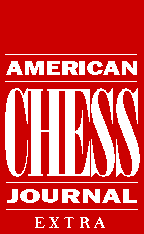
Notes of an Organizer and Player: The 1993 Hudson International
Daniel Edelman
The hallmark of European chess is the international round robin. A staple annual diet of events at Tilburg, Linares, and Wijk aan Zee has fueled European players with the highest octane of grandmaster competition. The strongest European tourneys nowadays -- at a remarkable Category XVIII! -- feature lavish conditions and enormous prize funds showered upon an exclusive clique of super-GMs, the top 20 players in the world. The United States, on the other hand, has hosted only a handful of high-quality Internationals: New York 1924 and 1927, Dallas 1957, the Piatigorsky Cups of 1963 and 1966, and San Antonio 1972. Lacking corporate backers and public acceptance of chess, American organizers have relied on large open Swisses to make chess semi-profitable.
In an effort to raise the level of American chess by imitating the European model, I have helped organize two strong round-robin events in the U.S.: the Reshevsky Memorial in New York in July 1992 (Category XII) won by Julio Granda Zuniga ahead of Judit Polgar; and the Hudson International in April 1993 (Category XIII), won by Alexander Shabalov.
What are the secrets of hosting Internationals? First, America needs more chess organizers and patrons who care about promoting the professional status of our top sportsmen. If you run a chess club, why not think big? Invite Kasparov, Karpov, the Polgars, and Deep Blue and create media spectacles. You think you can't raise enough money? Perhaps you should ask yourself, have you even tried? The second secret is television. Ken Ramaley and I succeeded despite all odds because the Hudson International was a televised affair. We're not talking about a local camera crew filming three seconds of footage for the evening news -- the Hudson International was a 30-minute chess show, aired thirteen times at prime-time, on a major cable station servicing 40,000 households. This exposure helped us acquire numerous sponsors, including several corporate backers.
At the Hudson International, I played the unusual double role of both tournament organizer and participant. This seventh-round win over Russian GM Alexander Goldin sewed up my third and final IM norm:
Goldin-Edelman, Hudson International 1993 Round 7
King's Indian E63
1 d4 Nf6 2 c4 g6 3 g3 Bg7 4 Bg2 0-0 5 Nc3 d6 6 Nf3 Nc6 7 0-0
This g3 line was quite popular at the Hudson International. Wojtkiewicz, with the black pieces against Goldin in round 3, played here 7 ... Bf5 8 Ne1 Na5 9 e4 Bg4 10 f3 Bd7 11 Qe2 Nc6 12 Nc2 e5. Yermolinsky tried the offbeat 5 ... Nc6!? (before ... d6) against Goldin in round 8. I veered into a line which is the heart of Goldin's preparation against the King's Indian.
7 ... a6 8 h3 Rb8 9 e4 b5 [D 1]
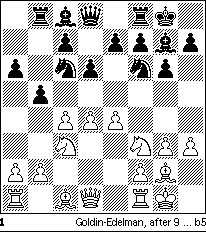
10 e5
White does best to keep cxb5 in reserve. If 10 cxb5 axb5 11 e5 Nd7 (11 ... dxe5 transposes to the next note) 12 e6 fxe6 13 d5 Nb4! (possible since d5 is now unprotected by a pawn) 14 Ng5 Nc5 15 dxe6 Bb7 16 Bxb7 Rxb7 17 Be3 Nbd3 =/+, Barlov-Piket, Wijk aan Zee (B) 1985. Or if 12 Ng5 dxe5 (12 ... Nxd4!? 13 Qxd4 Nxe5 14 Qh4 h6, Thorsteins-Van der Wiel, Reykjavik 1985; compare with 11 Ng5 below) 13 Bxc6 exd4 14 Nxb5 (14 Ne2? h6 15 Nf3 e5 gives Black powerful compensation) 14 ... Rb6 15 Na7 (15 Nxd4 Nb8!, Szekely-Weinstein, Budapest 1976 and Salov-Kuzmin, USSR 1981) and now best is 15 ... Nb8! 16 Bg2 Bb7 17 a4 Bxg2 18 Kxg2 c6 followed by 19 ... Rb7 pocketing the trapped knight on a7.
10 ... Nd7
The do-or-die continuation. When one thinks of this line, one recalls the contribution to theory of Ferdinand Hellers, another Hudson International participant. After this game, I asked Hellers what he thought of the line; he replied, curiously, that he hadn't examined it since the early 1980s. The alternative is 10 ... dxe5 11 dxe5 Qxd1 12 Rxd1 Nd7 13 e6 (13 cxb5 axb5 [13 ... Ncxe5!?] 14 Bf4 e6 = Krogius-Gheorghiu, Sochi 1976) 13 ... fxe6 14 cxb5 axb5 and now White has three possibilities:
a) 15 Ng5 Nd4 16 Be3 c5 17 Nce4 e5 18 Bxd4 cxd4 19 Ne6 (19 Rac1 Nf6) 19 ... Re8 20 Nc7 Rf8 =.
b) 15 Bf4 Nde5 (15 ... e5?! 16 Be3 is an inferior version of (c) below for Black, who lacks the e5 square for his pieces. Or 15 ... b4 16 Na4 Nb6 17 Nxb6 Rxb6 18 Bxc7 Rb7 [18 ... Ra6!?] 19 Bf4 Bxb2 20 Rab1 Bc3 21 Ng5 Rb6 22 Ne4 +/= Goldin-Gruenberg, Moscow GMA 1989) 16 Nxe5 Nxe5 17 Rac1 c5 18 Ne4 (possibly 18 Rc2 c4 19 Re2 as in Arkell-Byrne, London [Watson, Farley & Williams] 1991, but if 18 Re1 Rxf4! 19 gxf4 Nd3) 18 ... c4 19 Nc5 Rb6 = Goldin-Gleizerov, USSR 1986 and Petursson��-Nunn, Thessaloniki (ol) 1984.
c) 15 Be3 and now:
c1) 15 ... Nb4? 16 Rac1 Bxc3 17 bxc3 Nd5 18 Bh6 +/-.
c2) 15 ... Nd8 16 Rd2 Nf6 17 Ne5 b4 18 Na4 Nd5 19 Bd4 Ra8 20 b3 +/=.
c3) 15 ... b4 16 Na4 ( 16 Ne4 Bxb2 17 Rab1 Nde5!? 18 Rxb2 Nxf3+ with complications, Korchnoi-Gruenfeld, Jerusalem 1986) 16 ... Nce5 17 Nxe5 Bxe5 18 Bc6 Bd6 19 Ba7 Ne5?! 20 Bxb8 Nxc6 21 Bxc7 Bxc7 22 Rac1 Bb7 23 Rd7 Rc8 24 Nb6 +/=, Lagunov-Yusupov, USSR 1988. Better is 19 ... Rb7!? 20 Bxb7 Bxb7 with compensation. If instead 17 Nd4 (17 Ng5 Nf6 18 Nc5 Rb6 unclear) 17 ... Nb6 18 Nxb6 Rxb6 19 Rac1 Rd6 20 Rxc7 Ba6 21 Rxe7 Rfd8! =/+, Nikolic-Zapata, Tunis (izt) 1985.
c4) 15 ... Nb6!? 16 Ne1 (16 Nd4 Nxd4 17 Bxd4 Bxd4 18 Rxd4 c5 19 Rdd1 Bd7 =) 16 ... Nb4 17 Rac1 Bxc3 18 Rxc3 N6d5 unclear. Another possibility is 16 Ng5 Nb4 17 Rac1 (17 Nxb5 and 17 Bc5 turn out poorly for White) 17 ... h6 18 Nf3 N4d5 =/+, Nikolic-Filipovic, Banja Luka 1981.
After the text move, the attempt 11 Ng5 can be met by 11 ... Nxd4!? 12 Qxd4 Nxe5 13 Qh4 h6 14 Nce4 e6 15 Qxd8 Rxd8 16 cxb5 axb5 with compensation (Boleslavsky).
11 e6
11 cxb5 axb5 12 Ng5 transposes to the note to White's 10th move, as would 12 cxb5 in the game.
11 ... fxe6 12 d5 [D 2]
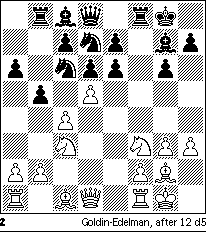
12 ... Nce5!?
I came up with this novelty in 1987 but never had the opportunity to test it. Black has tried various setups to defend the weak squares c6 and e6 (against Nd4). I reasoned, however, that d5 was the key square in this position. My logic and conclusion were based on numerous attempts in practice:
1. Sacrificial tries: Losing is 12 ... Rxf3? 13 dxc6 Rxc3 14 cxd7 Rxc1 15 dxc8(Q) Rxd1 16 Qxd8+. Ineffective is 12 ... b4? 13 dxc6 bxc3 14 cxd7 cxb2 15 Bxb2 or 14 ... Bxd7 15 bxc3 Bxc3 16 Bh6. Hebden once tried 12 ... bxc4?! against Manor in 1987, but after 13 dxc6 Nc5, White could have improved with 14 Qe2! d5 15. Ne5 +/= or 14 ... Nd3 15. Ng5 +/=.
2. Black knights on a7 and f6/b6: After 12 ... exd5 13 cxd5 Na7 14 Nd4 Nf6, Goldin lost with White against Romero Holmes in 1989. However, the obvious and strong 14 Be3! Nb6 15 Ng5 c5 16 dxc6 e6 17 Rc1 tied Black up in Kanko-Teichmann, correspondence 1985. Complicated but probably insufficient for Black is 14 ... c5!? 15 dxc6 Nxc6.
3. Black knights on a5 and f6: 12 ... exd5 13 cxd5 Na5 14 Nd4 Nf6 15 b4 e5 16 dxe6 c5 17 bxa5 cxd4 18 Ne2 +/-, Moldobaev-Gleizerov. Or 12 ... Na5 13 cxb5 exd5 14 Nd4 Nf6 15 Nxd5 axb5 16 Bd2 +/-, Geller-Chiburdanidze, USSR 1981.
4. Black knights on a5 and e5 with ... exd5: After 12 ... exd5 13 cxd5 (the point was 13 Qxd5+? Kh8 14 Qxc6? Bb7) 13 ... Na5 14 Nd4 Ne5, Black seems to have sufficient countermeasures, such as 15 b4 Nac4 16 f4 c5!, Geller-Gufeld, USSR 1981. But after the regrouping 15 Nce2!! (played first by Portisch against Vigh, Hungary, 1986), the maneuver Nf4-e6 is too dangerous for black. White won this way in several games including Goldin-Kosanovic, Belgrade 1988, which I had studied in advance and was eager to avoid.
5. Black knights on a5 and e5 with a delayed ... exd5: After 12 ... Na5 13 cxb5 exd5 14 Nd4 Nf6 15 Nxd5 axb5 16 Bd2! white was in command in Geller-Chiburdanidze, Moscow 1981. Can black deviate on move 13, 14, or 15?
My plan was to achieve a favorable version of IV and V by placing my knights on b6 and e5. The knight on b6, as opposed to a5, controls the d5 square rather than c6, and is less vulnerable to attack. The immediate point is that 13 Ng5 can be met by 13 ... Nc5! -/+.
13 Nd4 Nb6 14 cxb5 [D 3]
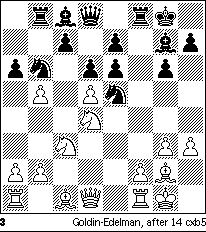
14 ... Nxd5!?
Here is a critical juncture where Black may be able to force matters and avoid White's game continuation. First, however, Black must decide whether the resulting positions (which I managed to convert to a win) are more dangerous than the continuation below. If not, then the text move is best, since it grants White one extra (inferior) alternative. The line could continue 14 ... exd5 15 f4 (15 bxa6 e6! -/+; 15 Nxd5 axb5) 15 ... c5 16 bxc6 Nf7 17 Nxd5 Nxd5 18 Bxd5 Bxh3 (I considered 18 ... Rb4, 18 ... Qb6, and 18 ... e6 too) 19 Rf2 Bg4! (better than 19 ... Rb4, 19 ... Qb6, or 19 ... Kh8) 20 Qa4 (20 Qd3 Qa5! eyeing ... Qe1+) 20 ... Qb6 21. Be3 Qb4 or 21 ... Qc5 with considerable counterplay. In Chessbase Magazine, GM Dautov suggests 17 f5! Bxd4+ 18 Qxd4 Bxf5 19 Nxd5 Nxd5 20 Bxd5 e6 (20 ... Bxh3? 21 Bh6 +- or 20 ... e5? 21 Qc4 +/-) 21 Bg2! (21 Rxf5 exd5! 22 Rf3 Qc8 with counterplay) 21 ... Qb6 22 Qxb6 Rxb6 23 g4 Bd3 24 Rf6 +/-. But Black might simply play 17 ... gxf5 18 Nxd5 Nxd5 19 Bxd5 Bxd4 20 Qxd4 e6 with good play thanks to his central pawns. Now, instead of the game continuation, White could try a reasonable idea of Dautov: 15 f4!? c5 16 bxc6 Nf7 17 Kh2!? (for 17 Nd5 see below; 17 Nxe6? Qb6+ 18 Kh2 Nxc3 19 Qe1 Bxe6 20 Qxe6 Nb5 -+) 17 ... Qb6 18 Nce2 with unclear prospects.
15 Nxd5 exd5 16 f4 c5 [D 4]
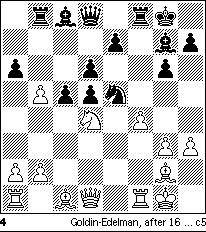
17 Bxd5+
Goldin thought for 30 minutes on this move, and later criticized himself for not transposing into the above variation with 17 bxc6 Nf7 18 Bxd5. After the game I discovered in ChessBase that my novelty had been tried once before, with the continuation 18 Kh2? e5 19 Nb3 d4 -/+, Den Boer-De Vries, Dieren open 1990. (In that game Black had chosen 14 ... Nxd5 as well.) Over the board I also considered 18 f5!? Qa5! and 18 Bxd5 Bxh3 19 Rf2 Qa5! 20 Ne6 Bxe6 21 Bxe6 Qc5! with 22 ... Bd4 to follow. After the game continuation 17 Bxd5+, Black cannot play 17 ... Nf7 because of the simple 18 Nc6 Qd7 19 Nxb8 Qxh3 20 Qe1.
17 ... Kh8 18 Ne6
Wrong is 18 bxa6? Bxh3 19 a7? Ra8 -/+ (Dautov).
18 ... Bxe6 19 Bxe6 Nf7 [D 5]
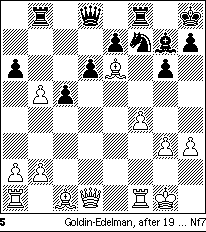
White thinks he is better: he has an extra pawn (after capturing on a6), the two bishops, and Black has a misplaced knight. However, Black has certain permanent advantages such as queenside Benko-type pressure, a mobile center, and a strong dark-squared bishop. White's next move is certainly an error, allowing Black to shuffle his knight to a stupendous outpost.
20 Qd5? Nh6 21 bxa6 Qa5! 22 Qd3 Nf5 23 Rb1 Nd4 24 Bd5
If 24 Bc4 e6 planning ... d5. White hopes to block out the black rook with Bb7, but is too slow. Black is already better.
24 ... Rb6! 25 Bc4 e6 [D 6]
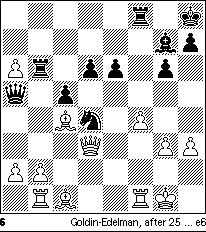
26 Qd1
Threatening 27 Bd2, which, if played immediately, could have been met simply by 26 ... Qa4.
26 ... Qb4! 27 b3 d5 28 Bd3
If 28 Bd2 Qa3, when Black can play to win both a-pawns. My next move creates additional threats involving ... Qd4+, hence White's reply. Goldin was already in time pressure.
28 ... Nb5 29 Kh2 Rxa6! 30 a4 Nc3 31 Bd2 Rb6 32 Qf3 Qd4 33 Bxc3 Qxc3 34 Bb5 Qc2+ [D 7]
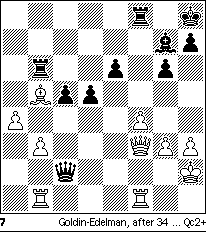
Here I made a surprising decision and offered Goldin a draw. The offer was based on tournament, game, and psychological factors. In rounds four through six I had lost to Benjamin and Hellers in winning positions and let Shabalov, the eventual tournament winner, escape with a draw. The position here I judged favorable to Black. However, no clear-cut continuation stood out, and I was concerned that I might ruin things again. Nevertheless, I had a sixth sense, glancing at Goldin's face, that he wanted to play on and would never accept a draw, even if the position were objectively inferior for him. Since Goldin had one minute for the remaining six moves, the offer was perfectly timed to interfere with his natural train of thought.
35 Qg2 Qf5 36 Rbc1 Bd4 37 Qe2 Rfb8 38 Kg2 Qf6 39 Rfd1 g5! 40 Rf1 Rg8 [D 8]
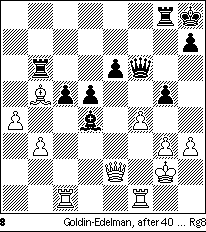
Time pressure is over and White is getting mauled. Black's bishop cannot be opposed in the attack, and the rook on b6 is awaiting transfer to g7 (via b7) or g6 (after ... e5). Goldin errs and the rest of the game is a slow mop-up job. I might have had quicker ways to win, but chose the safest road to the full point.
41 Qf3 gxf4 42 Qxf4 Qxf4 43 Rxf4 Be3 44 Rff1 Bxc1 45 Rxc1 Rc8 [D 9]
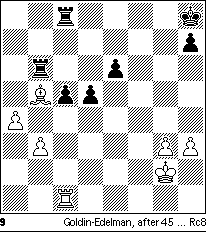
46 Kf3 Kg7 47 Ke3 Kf6 48 Kd3 Ke7 49 g4 e5 50 Kc3 Rf8 51 Kb2 Kd6 52 Rg1 e4 53 g5 Ke5 54 h4 Rf2+ 55 Ka3 Rh2 56 Rc1 Kd6 57 Rf1 Ke5 58 Rc1 e3 59 Rxc5 Rxh4 60 Rc2 Rf4 61 Rc8 Kd4 62 Be2 Rf2 63 a5 Rg6
Of course here 63 ... Re6 might have been faster. I wanted to gobble all of his pawns. White is soon in zugzwang.
64 Bb5 Rxg5 65 a6 Rg7 66 Re8 Ra7! 67 Kb4 Ra2 68 Re6 h5 69 Ba4 h4 70 Kb5 Ra3 71 Kb6 Rxa6+ 72 Kxa6 h3 73 Rh6 Rxa4+ 0-1
The victory finally came at 11:30 PM and brought applause from the audience. I later learned, however, that some were applauding not only my IM title achievement but also the fact that the spectators would not have to suffer through an adjournment! All in all, it was my most satisfying game from the Hudson International.
Daniel Edelman is an international master with degrees from Harvard and Columbia Universities, and the author of "Cooks, Forks, Waiters: Chess Problems and Nabokov's The Defense," published in ACJ 3 (1995). This article was written in 1998 and was published for the first time in ACJ Extra.
This page last modified on
28 April 2018.
Copyright (c) 1995-2018 Christopher F. Chabris. All rights
reserved.









